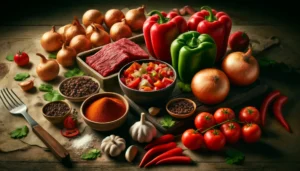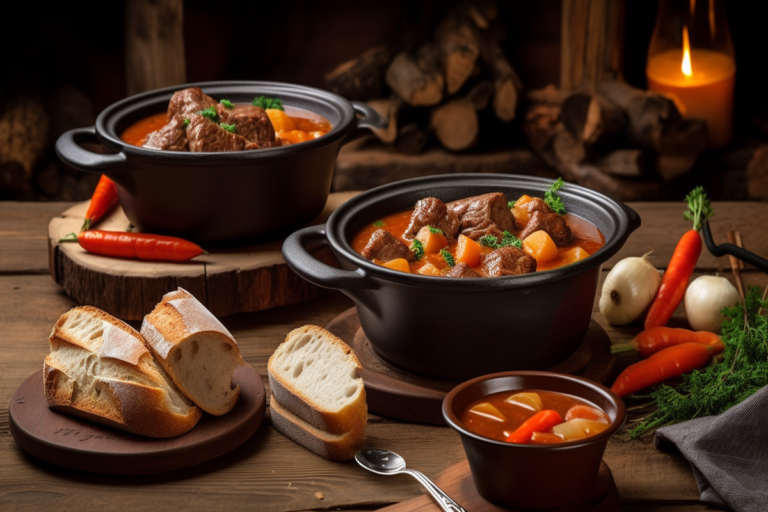Hungarian Goulash, a robust stew known for its deep, paprika-laden flavor, has long been a staple of Hungarian cuisine and a symbol of the nation’s culinary heritage. This dish, rich in history and taste, is a comforting blend of meat, vegetables, and spices, simmered slowly to perfection. In this guide, we’ll explore everything you need to know to master the art of making authentic Hungarian Goulash, from selecting the right ingredients to understanding the traditional cooking methods that define its unique flavor.
Introduction to Hungarian Goulash
What is Hungarian Goulash?
Hungarian Goulash (gulyás in Hungarian) originally started as a dish made by shepherds in the fields. They would cook pieces of seasoned meat until tender and flavored with Hungary’s quintessential spice: paprika. Over the centuries, this simple herdsman’s meal has evolved into one of Hungary’s national dishes, cherished both in its home country and abroad.
Goulash is distinctive for its use of paprika, a spice that not only imparts a vibrant red color but also contributes a subtle sweetness and warmth, which defines the dish’s character. Unlike other stews, Hungarian Goulash is traditionally more of a soup, with a thinner consistency that includes chunks of beef, potatoes, onions, and vegetables, seasoned liberally with paprika and other spices.
Understanding the roots and variations of this dish not only enriches the experience of cooking it but also deepens the appreciation for Hungarian culture. For those interested in exploring more traditional dishes, check out this detailed guide on making the perfect Pulled Pork Sandwich, another hearty favorite. As we delve into the key ingredients needed to create an authentic Goulash, remember that each element plays a pivotal role in bringing the flavors of this historic dish to life. For a detailed exploration, check out the Food Network’s take on Hungarian Goulash, which highlights traditional ingredients and methods.
Key Ingredients for Hungarian Goulash
Essential Spices and Herbs
Creating authentic Hungarian Goulash begins with gathering the right ingredients, which are pivotal in achieving the rich flavors and vibrant colors characteristic of this traditional dish.

Choosing the Right Meat
The choice of meat is crucial in goulash. Typically, beef is used, specifically chuck, which is well-marbled and becomes tender and flavorful when cooked slowly. It’s important to cut the beef into uniform chunks to ensure even cooking.
Vegetables and Spices
- Onions and Garlic: These form the aromatic base for the stew, providing depth and flavor.
- Bell Peppers: Both red and green bell peppers are added for a slight sweetness and color.
- Tomatoes: Fresh tomatoes or a spoonful of tomato paste can be used to add richness and a subtle acidity that balances the dish.
- Caraway Seeds: Often used in Eastern European cooking, these seeds add a distinctive earthy note to the dish.
- Paprika: This is the signature spice of Hungarian Goulash. Using high-quality, sweet Hungarian paprika is key to achieving the authentic flavor.
In the accompanying image, you can see all these ingredients laid out, ready to be transformed into a delicious goulash. Each component plays a specific role in building the complex flavors that define this iconic Hungarian dish.
Step-by-Step Cooking Process for Hungarian Goulash
Preparing the Base
Creating a flavorful base is essential for a rich and hearty goulash. Here’s how to begin:
Initial Preparation
- Chop the Vegetables: Dice onions, slice bell peppers, and crush the garlic.
- Cut the Meat: Cube the beef into uniform pieces to ensure even cooking.
Browning the Meat
- Seasoning the Beef: Toss the beef chunks with salt and coat them in paprika.
- Searing: Heat oil in a Dutch oven or heavy pot and sear the beef until browned on all sides. Remove and set aside.
The Slow Cooking Method
The slow cooking process is what makes goulash uniquely tender and flavorful. Here’s how to continue after preparing the base:
| Step | Action | Purpose |
|---|---|---|
| 1. Sauté the Vegetables | Cook the onions, garlic, and bell peppers in the same pot until soft. | To build a flavor foundation for the goulash. |
| 2. Deglaze | Add a splash of water or broth to lift the browned bits off the bottom of the pot. | To incorporate all the caramelized flavors. |
| 3. Add Spices | Return the beef to the pot with additional paprika and caraway seeds. | To infuse the meat with deep, aromatic flavors. |
| 4. Simmer | Pour in enough water or broth to cover the ingredients, and bring to a boil. Reduce to a simmer. | To let the tastes blend together and the meat to become tender. |
| 5. Final Seasonings | Adjust salt and add a bay leaf. Continue to simmer for about 1-2 hours until meat is tender. | To enhance the overall taste and tenderness of the dish. |
Monitoring and Stirring
- Consistency: Check the stew occasionally to ensure it doesn’t dry out. Add more liquid if necessary.
- Tenderness: Test the meat for tenderness after about 1 hour of simmering. Continue cooking until the beef is fork-tender.
This methodical approach to cooking Hungarian Goulash ensures that each component melds together perfectly, resulting in a dish that is both comforting and deeply satisfying. By following these steps, even a novice cook can create a goulash that tastes authentic and flavorful.
Regional Variations of Hungarian Goulash
Comparing Hungarian and Central European Goulash
Hungarian Goulash has inspired numerous adaptations across Central Europe, each bringing its own local flavors and ingredients into the mix. Understanding these variations not only highlights the dish’s versatility but also its cultural significance in different regions.
Hungarian Goulash (Gulyás)
- Origin: Traditionally, Hungarian Goulash is a soup, not a stew, known locally as ‘Gulyásleves’.
- Ingredients: It typically features chunks of beef, potatoes, onions, tomatoes, green peppers, and a generous amount of paprika.
- Consistency: This version is thinner, more like a soup, and is often served with bread on the side rather than noodles or dumplings.
Czech and Slovakian Goulash
- Adaptations: In the Czech Republic and Slovakia, goulash usually takes a thicker, stew-like form and is more commonly served with bread dumplings (knedlíky).
- Spicing: These versions might include marjoram or majoram and less paprika compared to the Hungarian version, focusing more on a balanced, less spicy flavor profile.
Austrian Goulash
- Variety: Austrian goulash often includes both beef and onions in equal proportions, emphasizing a rich onion gravy.
- Serving: It’s typically served with a side of spaetzle, small egg noodles, which differ from the Hungarian preference for potatoes.
| Country | Type | Ingredients | Serving Suggestion |
|---|---|---|---|
| Hungary | Soup | Beef, potatoes, onions, paprika | Bread |
| Czech Republic | Stew | Beef, onions, marjoram, less paprika | Bread dumplings (knedlíky) |
| Austria | Stew | Beef, onions in equal measure, paprika | Spaetzle |
Cultural Impact and Preferences
Each variation of goulash reflects local preferences and available ingredients, showing how a simple herdsman’s meal has evolved into a regional comfort food staple. The dish’s adaptability has allowed it to remain popular and relevant, with each country adding its own signature to this Central European classic.
By exploring these regional differences, we gain insight into how Hungarian Goulash has influenced and been influenced by neighboring cuisines, making it a truly international dish. In the next part, we will discuss the best ways to serve and pair Hungarian Goulash to enhance its flavors and appeal.
Serving and Pairing Hungarian Goulash
Enhancing the Dining Experience
After exploring how to make traditional Hungarian Goulash, it’s important to consider how best to serve and pair this hearty dish to fully appreciate its flavors and textures.
Ideal Accompaniments
The classic way to serve Hungarian Goulash is with a side that complements its rich and savory sauce. Here are some traditional and modern accompaniments:
- Dumplings: In Hungary, goulash is often served with small dumplings called nokedli, similar to German spaetzle, which are perfect for soaking up the flavorful sauce.
- Bread: A crusty loaf of bread is another excellent option, ideal for those who prefer a simpler side that lets the goulash shine.
- Potatoes: Boiled or mashed potatoes can also serve as a mild base for the stew, balancing the strong flavors.
Wine Pairings
Selecting the right wine to accompany goulash can enhance the dining experience:
- Red Wines: A medium-bodied red wine, such as a Merlot or a Hungarian Egri Bikavér (Bull’s Blood), can complement the paprika and beef flavors without overwhelming them.
- White Wines: For those who prefer white wine, a full-bodied white like a Chardonnay can stand up to the robust flavors of the goulash.
The image below showcases a beautifully served plate of traditional Hungarian Goulash, emphasizing the dish’s hearty and comforting nature, making it a welcoming meal for any occasion.
In the next section, we’ll address some frequently asked questions about Hungarian Goulash, providing additional tips and insights to help you perfect your goulash-making skills.

